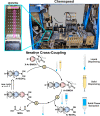Autonomous Chemical Experiments: Challenges and Perspectives on Establishing a Self-Driving Lab
- PMID: 35948428
- PMCID: PMC9454899
- DOI: 10.1021/acs.accounts.2c00220
Autonomous Chemical Experiments: Challenges and Perspectives on Establishing a Self-Driving Lab
Abstract
We must accelerate the pace at which we make technological advancements to address climate change and disease risks worldwide. This swifter pace of discovery requires faster research and development cycles enabled by better integration between hypothesis generation, design, experimentation, and data analysis. Typical research cycles take months to years. However, data-driven automated laboratories, or self-driving laboratories, can significantly accelerate molecular and materials discovery. Recently, substantial advancements have been made in the areas of machine learning and optimization algorithms that have allowed researchers to extract valuable knowledge from multidimensional data sets. Machine learning models can be trained on large data sets from the literature or databases, but their performance can often be hampered by a lack of negative results or metadata. In contrast, data generated by self-driving laboratories can be information-rich, containing precise details of the experimental conditions and metadata. Consequently, much larger amounts of high-quality data are gathered in self-driving laboratories. When placed in open repositories, this data can be used by the research community to reproduce experiments, for more in-depth analysis, or as the basis for further investigation. Accordingly, high-quality open data sets will increase the accessibility and reproducibility of science, which is sorely needed.In this Account, we describe our efforts to build a self-driving lab for the development of a new class of materials: organic semiconductor lasers (OSLs). Since they have only recently been demonstrated, little is known about the molecular and material design rules for thin-film, electrically-pumped OSL devices as compared to other technologies such as organic light-emitting diodes or organic photovoltaics. To realize high-performing OSL materials, we are developing a flexible system for automated synthesis via iterative Suzuki-Miyaura cross-coupling reactions. This automated synthesis platform is directly coupled to the analysis and purification capabilities. Subsequently, the molecules of interest can be transferred to an optical characterization setup. We are currently limited to optical measurements of the OSL molecules in solution. However, material properties are ultimately most important in the solid state (e.g., as a thin-film device). To that end and for a different scientific goal, we are developing a self-driving lab for inorganic thin-film materials focused on the oxygen evolution reaction.While the future of self-driving laboratories is very promising, numerous challenges still need to be overcome. These challenges can be split into cognition and motor function. Generally, the cognitive challenges are related to optimization with constraints or unexpected outcomes for which general algorithmic solutions have yet to be developed. A more practical challenge that could be resolved in the near future is that of software control and integration because few instrument manufacturers design their products with self-driving laboratories in mind. Challenges in motor function are largely related to handling heterogeneous systems, such as dispensing solids or performing extractions. As a result, it is critical to understand that adapting experimental procedures that were designed for human experimenters is not as simple as transferring those same actions to an automated system, and there may be more efficient ways to achieve the same goal in an automated fashion. Accordingly, for self-driving laboratories, we need to carefully rethink the translation of manual experimental protocols.
Conflict of interest statement
The authors declare the following competing financial interest(s): A. Aspuru-Guzik is the co-founder and Chief Visionary Officer of Kebotix Inc.
Figures





Similar articles
-
Toward Self-Driven Autonomous Material and Device Acceleration Platforms (AMADAP) for Emerging Photovoltaics Technologies.Acc Chem Res. 2024 May 7;57(9):1434-1445. doi: 10.1021/acs.accounts.4c00095. Epub 2024 Apr 23. Acc Chem Res. 2024. PMID: 38652511 Free PMC article.
-
Planning Implications Related to Sterilization-Sensitive Science Investigations Associated with Mars Sample Return (MSR).Astrobiology. 2022 Jun;22(S1):S112-S164. doi: 10.1089/AST.2021.0113. Epub 2022 May 19. Astrobiology. 2022. PMID: 34904892
-
The future of Cochrane Neonatal.Early Hum Dev. 2020 Nov;150:105191. doi: 10.1016/j.earlhumdev.2020.105191. Epub 2020 Sep 12. Early Hum Dev. 2020. PMID: 33036834
-
Toward autonomous design and synthesis of novel inorganic materials.Mater Horiz. 2021 Aug 1;8(8):2169-2198. doi: 10.1039/d1mh00495f. Epub 2021 May 26. Mater Horiz. 2021. PMID: 34846423 Review.
-
Self-Driving Laboratories for Development of New Functional Materials and Optimizing Known Reactions.Nanomaterials (Basel). 2021 Mar 2;11(3):619. doi: 10.3390/nano11030619. Nanomaterials (Basel). 2021. PMID: 33801472 Free PMC article. Review.
Cited by
-
Autonomous mobile robots for exploratory synthetic chemistry.Nature. 2024 Nov;635(8040):890-897. doi: 10.1038/s41586-024-08173-7. Epub 2024 Nov 6. Nature. 2024. PMID: 39506122 Free PMC article.
-
Accelerated chemical science with AI.Digit Discov. 2023 Dec 6;3(1):23-33. doi: 10.1039/d3dd00213f. eCollection 2024 Jan 17. Digit Discov. 2023. PMID: 38239898 Free PMC article. Review.
-
Expanding chemistry through in vitro and in vivo biocatalysis.Nature. 2024 Jul;631(8019):37-48. doi: 10.1038/s41586-024-07506-w. Epub 2024 Jul 3. Nature. 2024. PMID: 38961155 Review.
-
Efficient degassing and ppm-level oxygen monitoring flow chemistry system.React Chem Eng. 2023 Apr 28;8(8):2052-2059. doi: 10.1039/d3re00109a. eCollection 2023 Jul 25. React Chem Eng. 2023. PMID: 37496729 Free PMC article.
-
Machine learning in drug delivery.J Control Release. 2024 Sep;373:23-30. doi: 10.1016/j.jconrel.2024.06.045. Epub 2024 Jun 26. J Control Release. 2024. PMID: 38909704 Free PMC article. Review.
References
-
- Häse F.; Roch L. M.; Aspuru-Guzik A. Next-Generation Experimentation with Self-Driving Laboratories. Trends Chem. 2019, 1, 282–291. 10.1016/j.trechm.2019.02.007. - DOI
Publication types
MeSH terms
LinkOut - more resources
Full Text Sources
Research Materials
Miscellaneous

